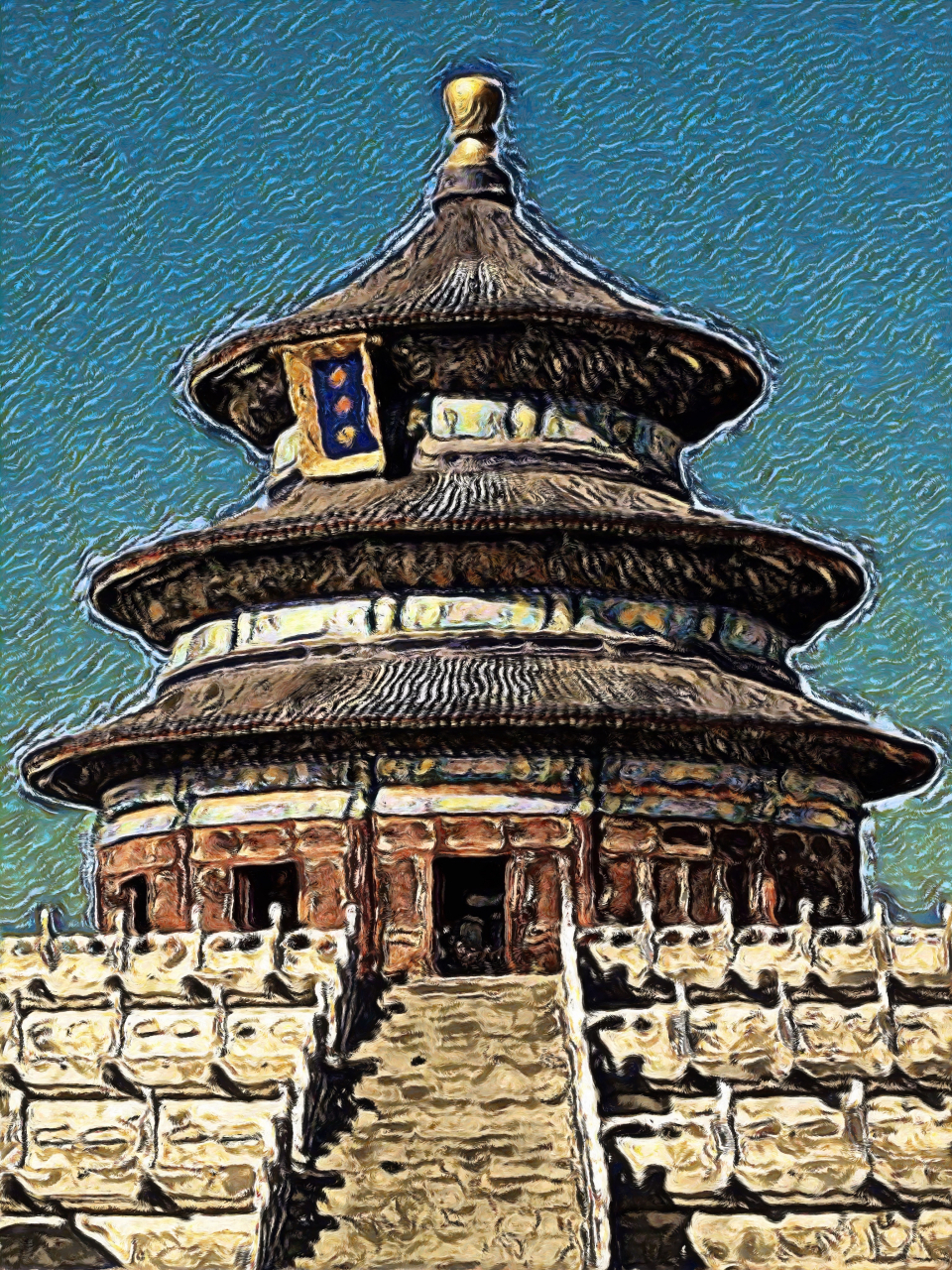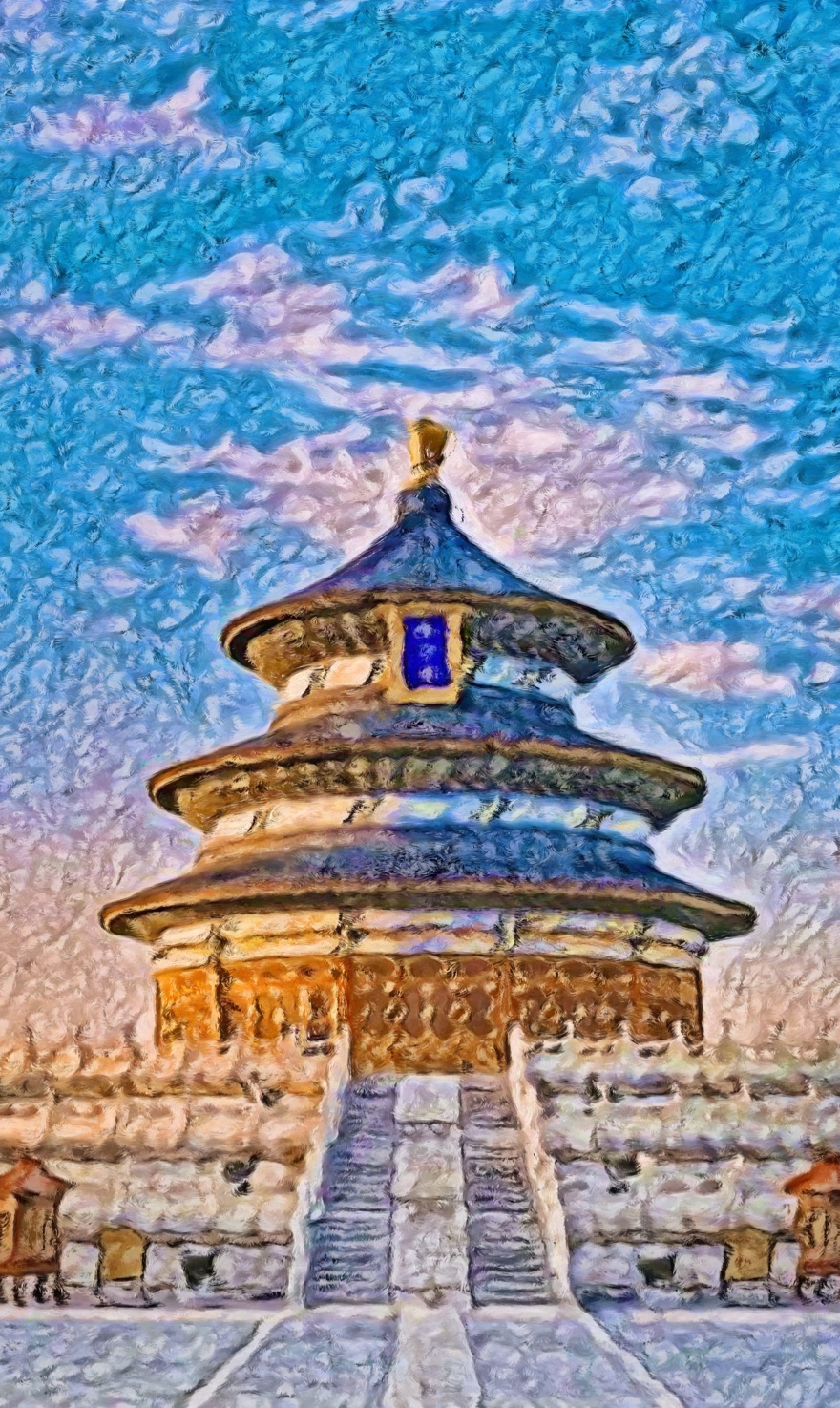世界風情畫「北京天壇-祈年殿」印象派大師-梵谷(線條)及莫內(光線)風格油彩畫作#12

Story
天壇,天圓地方,北京的象徵性建築
祈年殿,金碧輝煌,距離天帝最近的地方
畫作主題:北京天壇-祈年殿
「天壇」位於北京市東城區,是明清兩朝皇帝祭天、祈穀和祈雨的場所。是現存中國古代規模最大、倫理等級最高的祭祀建築群。
「天壇」是圜丘、祈谷兩壇的總稱,有壇牆兩重,形成內外壇,壇牆南方北圓,象徵天圓地方。主要建築在內壇,圜丘壇在南、祈谷壇在北,二壇同在一條南北軸線上,中間有牆相隔。圜丘壇內主要建築有圜丘壇、皇穹宇等等,祈谷壇內主要建築有祈年殿、皇乾殿、祈年門等。著名的祈年殿在最北方,這是天壇內最宏偉、最華麗的建築,也是想像中離天最近的地方。
壇面除中心的太極石是圓形外,外圍各圈均為扇面形,數目也是陽數,象徵九重天,天帝的牌位就安放在太極石上,象徵著天帝高居九重天之上。如果說天安門城樓是中國的象徵,那「天壇祈年殿」就是北京這座不朽名城的象徵。
「祈年殿」是天壇的主體建築,又稱祈谷殿,是明清兩代皇帝孟春祈谷之所。它是一座鎦金寶頂、藍瓦紅柱、金碧輝煌的彩繪三層重檐圓形大殿。祈年殿採用的是上殿下屋的構造形式。大殿建於高6米的白石雕欄環繞的三層漢白玉圓台上,即為祈谷壇,頗有拔地擎天之勢,壯觀恢弘。
「祈年殿」為磚木結構,殿高38米,直徑32米,三層重檐向上逐層收縮作傘狀。建築獨特,無大梁長檁及鐵釘,二十八根楠木巨柱環繞排列,支撐著殿頂的重量。祈年殿是按照“敬天禮神”的思想設計的,殿為圓形,象徵天圓;瓦為藍色,象徵藍天。
「祈年殿」的內部結構比較獨特:不用大梁和長檁,僅用楠木柱和枋桷相互銜接支撐屋頂。殿內柱子的數目,據說也是按照天象建立起來的。內圍的四根“龍井柱”象徵一年四季春、夏、秋、冬;中圍的十二根“金柱”象徵一年十二個月;外圍的十二根“檐柱”象徵一天十二個時辰。中層和外層相加的二十四根,象徵一年二十四個節氣。三層總共二十八根象徵天上二十八星宿。再加上柱頂端的八根銅柱,總共三十六根,象徵三十六天罡。
「天壇」是中國乃至全世界都難得一見的保存完好的壇廟建築群,其中心建築——「祈年殿」更是北京的象徵,1961年,「天壇」被國務院公布為第一批全國重點文物保護單位,1998年「北京皇家祭壇—天壇」被列為世界文化遺產。這裡除了慕名而來遊客外,更多的是一些打牌下棋聊天的北京大爺大媽們。當地人只要辦一張公園年票就可以免費進出,是一處市民消遣的好去處。
#世界風情畫「北京天壇-祈年殿」採用印象派大師-梵谷( Stripes )及莫內(Light )風格之油彩畫作。
#世界風情畫「北京天壇-祈年殿」油彩畫作限量發行 3 個vibe。
Temple of Heaven, round sky and place, a symbolic building in Beijing
The Hall of Prayer for Good Harvest, resplendent and golden, the closest place to the Emperor of Heaven
Painting subject: Beijing Temple of Heaven - Hall of Prayer for Harvest
The Temple of Heaven is located in Dongcheng District, Beijing. It was the place where the emperors of the Ming and Qing dynasties worshiped the sky, prayed for grain and prayed for rain. It is the largest existing sacrificial building complex in ancient China with the highest ethical level.
The Temple of Heaven is a general term for the two altars of Yuanqiu and Qigu. There are two altar walls, forming an inner and outer altar. The main building is the inner altar, the round mound altar is in the south, the Qigu altar is in the north, and the two altars are on the same north-south axis, separated by a wall. The main buildings in the Circular Mound Altar are the Circular Mound Altar, the Emperor Vault, etc. The main buildings in the Praying Valley Altar are the Hall of Prayer for Good Harvest, the Hall of Emperor Qiang, and the Gate of Prayer for New Years. The famous Hall of Prayer for Good Harvest is located in the far north. This is the most magnificent and gorgeous building in the Temple of Heaven, and it is also the closest place to the sky in imagination.
Except for the Taiji stone in the center, which is circular, the outer circles are fan-shaped, and the number is also a positive number, which symbolizes the nine heavens. If the Tiananmen Gate Tower is a symbol of China, the Temple of Prayer for Good Harvest is the symbol of this immortal city in Beijing.
The Hall of Prayer for Good Harvest is the main building of the Temple of Heaven, also known as the Hall of Prayer for Valleys. It is a three-story, double-eave circular hall with golden-gold roof, blue tiles and red columns, and brilliant painted colors. The Hall of Prayer for Good Harvest adopts the structural form of the upper and lower halls. The main hall is built on a three-story white marble round platform surrounded by a 6-meter-high white stone fence, which is the altar of prayers. The Hall of Prayer for Good Harvest is a brick and wood structure with a height of 38 meters and a diameter of 32 meters. The building is unique. There are no long beams, purlins and iron nails. Twenty-eight nanmu giant columns are arranged around and support the weight of the roof of the hall. The Hall of Prayer for Good Harvest is designed according to the idea of "respecting the heaven and worshiping the gods". The internal structure of the Hall of Prayer for Good Harvest is quite unique: no beams and long purlins are used, only nanmu columns and fangjue are used to support the roof. The number of pillars in the temple is also said to be built according to celestial phenomena. The four "Dragon Well Pillars" in the inner circle symbolize spring, summer, autumn and winter throughout the year; the twelve "golden pillars" in the middle circle symbolize the twelve months of the year; the twelve "eaves pillars" in the outer circle symbolize a day. twelve hours. The twenty-four roots in the middle layer and the outer layer symbolize the twenty-four solar terms in a year. A total of twenty-eight roots in the three layers symbolize the twenty-eight constellations in the sky. Together with the eight copper pillars at the top of the pillar, there are thirty-six in total, symbolizing the thirty-six heavenly gangs.
The Temple of Heaven is a rare well-preserved temple complex in China and even in the world. Its central building, the Hall of Prayer for Good Harvest, is a symbol of Beijing. In 1961, the Temple of Heaven was announced by the State Council as the first batch of national key cultural relics protection units. In 1998 "Beijing Royal Altar - Temple of Heaven" is listed as a world cultural heritage. In addition to tourists who come here, there are more Beijing uncles and aunts who play cards, play chess and chat. The local people can enter and leave for free as long as they apply for an annual pass to the park. It is a good place for citizens to spend time.
#World style painting "Beijing Temple of Heaven - Prayer Hall" uses oil paintings in the style of Impressionist masters - Van Gogh(Stripes )and (Light )Monet.
#World style painting "Beijing Temple of Heaven - Hall of Prayer for Harvest" oil paintings are limited to 3 vibes.
Tags
Created on 2022/04/28 00:55:08 UTC
Contract Address
0xD41bDc346dfCC6A6acCC219eDC2055005F32B3A4
- Token ID
- 58338
- Chain
- BNB Chain
- Token Standard
- BEP1155
- Metadata URL
- https://oursong.com/project/erc1155token-meta/58338.json


